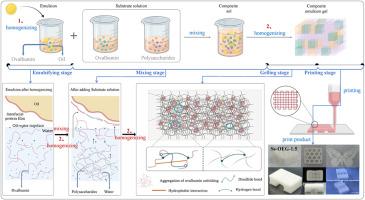Construction and formation mechanism of phase-change polysaccharide–protein composite emulsion gels: For simultaneous printing of food products with complex structures and fine patterns
IF 11
1区 农林科学
Q1 CHEMISTRY, APPLIED
引用次数: 0
Abstract
With the development of the intelligent direction of food 3D printing, people have a strong aesthetic interest in food printing prototypes. In order to investigate the ability of food-based materials to print complex structures and fine patterns simultaneously, three phase-change hydrocolloids with different mechanical strengths after cooling were selected: xanthan gums (Xg), low acyl gellan gums (Gg), and starches (Ss) with ovalbumin to form Xg-ovalbumin emulsion gel (Xg-OEG), Gg-ovalbumin emulsion gel (Gg-OEG), and Ss-ovalbumin emulsion gel (Ss-OEG), respectively. Ss-OEG printed fine patterns with a minimum size of 1.5 mm accurately at a Ss concentration of 1.5%, and was able to print suspended structures, had continuous filament strips and tight layer-to-layer stacking, with the ability to print complex structures and fine patterns simultaneously. Compared with Xg-OEG and Gg-OEG, Ss-OEG had high viscoelasticity and mechanical strength, suitable fluidity, small size of oil droplets without aggregation, dense network structure, and high surface hydrophobicity and amide A peak intensity and the low free sulfhydryl content. Thus, Ss endowed OEG with a certain viscoelasticity and mechanical strength, and caused massive aggregation of proteins through forming disulfide bonds, hydrophobic interactions, and hydrogen bonds. Aggregated ovalbumin and Ss formed a stable and strong network structure, emulsified oil droplets filled in the network, the three tightly crosslinked together to form an emulsion gel with excellent printing ability. This research offered the possibility of simultaneously printing complex structures, high-resolution patterns using food-based materials, also providing a theoretical basis for the design of complex and fine printed products.

相变多糖-蛋白质复合乳液凝胶的构造和形成机理:用于同时印刷具有复杂结构和精细图案的食品
随着食品3D打印智能化方向的发展,人们对食品打印原型产生了浓厚的审美兴趣。为了研究食品基材料同时打印复杂结构和精细图案的能力,我们选择了三种冷却后机械强度不同的相变水胶体:黄原胶(Xg)、低酰基结冷胶(Gg)和淀粉(Ss)与卵清蛋白分别形成Xg-卵清蛋白乳液凝胶(Xg-OEG)、Gg-卵清蛋白乳液凝胶(Gg-OEG)和Ss-卵清蛋白乳液凝胶(Ss-OEG)。在 Ss 浓度为 1.5% 的条件下,Ss-OEG 能准确地打印出最小尺寸为 1.5 mm 的精细图案,并能打印出悬浮结构、连续的丝带和紧密的层间堆叠,具有同时打印复杂结构和精细图案的能力。与 Xg-OEG 和 Gg-OEG 相比,Ss-OEG 具有较高的粘弹性和机械强度、适宜的流动性、油滴粒径小且不聚集、致密的网络结构、较高的表面疏水性和酰胺 A 峰强度以及较低的游离巯基含量。因此,Ss 赋予了 OEG 一定的粘弹性和机械强度,并通过形成二硫键、疏水作用和氢键,使蛋白质大量聚集。聚集的卵清蛋白和 Ss 形成了稳定而坚固的网络结构,乳化油滴填充在网络中,三者紧密交联在一起,形成了具有出色印刷能力的乳化凝胶。这项研究为利用食品基材料同时印刷复杂结构和高分辨率图案提供了可能,也为设计复杂精细的印刷产品提供了理论依据。
本文章由计算机程序翻译,如有差异,请以英文原文为准。
求助全文
约1分钟内获得全文
求助全文
来源期刊

Food Hydrocolloids
工程技术-食品科技
CiteScore
19.90
自引率
14.00%
发文量
871
审稿时长
37 days
期刊介绍:
Food Hydrocolloids publishes original and innovative research focused on the characterization, functional properties, and applications of hydrocolloid materials used in food products. These hydrocolloids, defined as polysaccharides and proteins of commercial importance, are added to control aspects such as texture, stability, rheology, and sensory properties. The research's primary emphasis should be on the hydrocolloids themselves, with thorough descriptions of their source, nature, and physicochemical characteristics. Manuscripts are expected to clearly outline specific aims and objectives, include a fundamental discussion of research findings at the molecular level, and address the significance of the results. Studies on hydrocolloids in complex formulations should concentrate on their overall properties and mechanisms of action, while simple formulation development studies may not be considered for publication.
The main areas of interest are:
-Chemical and physicochemical characterisation
Thermal properties including glass transitions and conformational changes-
Rheological properties including viscosity, viscoelastic properties and gelation behaviour-
The influence on organoleptic properties-
Interfacial properties including stabilisation of dispersions, emulsions and foams-
Film forming properties with application to edible films and active packaging-
Encapsulation and controlled release of active compounds-
The influence on health including their role as dietary fibre-
Manipulation of hydrocolloid structure and functionality through chemical, biochemical and physical processes-
New hydrocolloids and hydrocolloid sources of commercial potential.
The Journal also publishes Review articles that provide an overview of the latest developments in topics of specific interest to researchers in this field of activity.
 求助内容:
求助内容: 应助结果提醒方式:
应助结果提醒方式:


